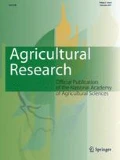Abstract
Evaluation of germplasm for mineral content and selecting varieties with high quantities of essential minerals and incorporating those varieties in breeding program can assist in developing mineral-efficient crops with higher yield which can accumulate minerals from marginal soil. Sesame an oldest oilseed crop is a popular food with medicinal value although its production is often focussed in marginal and sub-marginal lands. In the present study, 60 sesame genotypes of diverse origin collected from Bangladesh, Bulgaria, India and USA were examined in the acid-digested samples by atomic absorption spectrophotometer for Fe, Zn, Cu, Mn, Cr and Co contents. All elements except Cr were found to be highly variable among genotypes. A significant discrimination showed that elements content in the sesame seeds was a seed coat coloured specific character. High-yielding developed varieties of India contain high Zn but low Fe concentration in seed. The concentration of mineral elements in black-seeded genotypes was significantly higher than those in white seeded. The indigenous collections were found to be a good reservoir of mineral elements. Correlation study among trace elements and yield attributes indicated that though Fe and Zn were not correlated significantly with yield and its components, but the two elements were interrelated. Phenotypic and genotypic coefficient of variability and heritability were high for Fe and Zn. The study suggests that observed large genetic variability for element concentrations in the genotypes provides good prospects to breed improved sesame cultivars with elevated levels of micronutrients to mitigate mineral deficiency.



Similar content being viewed by others
References
Akpapunam MA, Sefa-Dedeh S (1995) Traditional lactic acid fermentation, malt addition, and quality development in maize-cowpea weaning blends. Food Nutr Bull 16:75–80
Allard RW (1960) Principal of plant breeding. Wiley, New York
Alobo A (2001) Effect of sesame seed flour on millet biscuit characteristics. Plant Foods Hum Nutr 56:195. doi:10.1023/A:1011168724195
Alyemeni MN, Basahy AY, Sher H (2011) Physico-chemical analysis and mineral composition of some sesame seeds (Sesamum indicum L.) grown in the Gizan area of Saudi Arabia. J Med Plants Res 5:270–274
Burton GW (1952) Quantitative inheritance in Grasses. In: Proceedings of the sixth international grassland congress, pp 227–283
Cao L, Geng W, Wei YS (2012) Determination of 18 mineral elements of (Sesamum indicum L.) by microwave digestion-ICP-OES. Appl Chem Ind 5:910–913
Dar AA, Verma NK, Arumugam N (2015) An updated method for isolation, purification and characterization of clinically important antioxidant lignans–Sesamin and sesamolin, from sesame oil. Ind Crops Prod 64:201–208
Graham RD, Welch RM (1996) Breeding for staple food crops with high micronutrient density. International Food Policy Research Institute, Washington
Kanatti A, Rai KN, Radhika K, Govindaraj M, Sahrawat KL, Rao AS (2014) Grain iron and zinc density in pearl millet: combining ability, heterosis and association with grain yield and grain size. Springer Plus 3:763
Kotecha PV (2011) Nutritional anemia in young children with focus on Asia and India. Indian J Community Med 36:8–16
Morgounov A, Gomez-Becerra HG, Abugalieva A, Dzhunusova M, Yessimbekova M, Miminjanov H, Zelenskiy Y, Ozturk L, Cakmak I (2007) Iron and zinc grain density in common wheat grown in Central Asia. Euphytica 155:193–203
Morris JB (2002) Food, industrial, nutraceutical, and pharmaceutical uses of sesame genetic resources. Trends in new crops and new uses. ASHS press, Alexandria VA, pp 153–156
Obiajunwa EI, Adebiyi FM, Omode PE (2005) Determination of essential minerals and trace elements in Nigerian sesame seeds, using TXRF technique. Pak J Nutr 4:3–395
Özcan M (2003) Antioxidant activities of rosemary, sage, and sumac extracts and their combinations on stability of natural peanut oil. J Med Food 6:267–270
Pandey SK, Das A, Dasgupta T (2013) Genetics of seed coat colour in sesame (Sesamum indicum L.). Afr J Biotechnol 12:6061–6066
Pandey SK, Das A, Rai P, Dasgupta T (2015) Morphological and genetic diversity assessment of sesame (Sesamum indicum L.) accessions differing in origin. Physiol Mol Biol Plants 21(4):519–529. doi:10.1007/s12298-015-0322-2
SPSS Inc. Released (2008) SPSS Statistics for Windows, Version 17.0. Chicago
Sani I, Sule FA, Warra AA, Bello F, Fakai IM, Abdulhamid A (2013) Phytochemicals and mineral composition of white Sesamum indicum L. Seed Oil. Int J Trad Nat Med 2(118):130
Sarwar G, Haq MA, Chaudhry MB, Rabbani I (2007) Evaluation of early and high yielding mutants of sesame (Sesamum indicum L.) for different genetic parameters. J Agric Res 45:125–133
Soetan KO, Olaiya CO, Oyewole OE (2010) The importance of mineral elements for humans, domestic animals and plants: a review. Afr J Food Sci 4:200–222
Upadhyaya H, Ortiz R (2001) A mini core subset for capturing diversity and promoting utilization of chickpea genetic resources in crop improvement. Theor Appl Genet 102:1292. doi:10.1007/s00122-001-0556-y
Uzun B, Engin Y, Furat S (2013) Genetic advance, heritability and inheritance in determinate growth habit of sesame. Aust J Crop Sci 7:978–983
White PJ, Broadley MR (2005) Biofortifying crops with essential mineral elements. Trends Plant Sci 10:586–593
World Health Organization (2002) The world health report: reducing risks, promoting healthy life. World health Organisation Press, Geneva
Yol E, Karaman E, Furat S, Uzun B (2010) Assessment of selection criteria in sesame by using correlation coefficients, path and factor analyses. Aus J Crop Sci 4:598–602
Author information
Authors and Affiliations
Corresponding author
Electronic supplementary material
Below is the link to the electronic supplementary material.
Rights and permissions
About this article
Cite this article
Pandey, S.K., Majumder, E. & Dasgupta, T. Genotypic Variation of Microelements Concentration in Sesame (Sesamum indicum L.) Mini Core Collection. Agric Res 6, 114–121 (2017). https://doi.org/10.1007/s40003-017-0252-z
Received:
Accepted:
Published:
Issue Date:
DOI: https://doi.org/10.1007/s40003-017-0252-z




